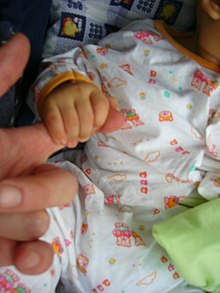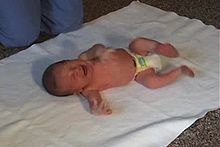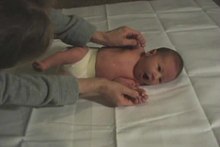Early childhood reflex
As early childhood or primitive reflex or primitive reflex ( English neonatal reflex ) is used in the medicine indicates a typical reaction and reproducible pattern on specific external stimuli. These reflexes take place without the involvement of the cerebrum and serve to search for and eat food and to protect oneself . They can be observed in the first few weeks and months of a child's life and are then gradually suppressed by the frontal lobes as the cerebrum develops . If the early childhood reflexes reappear in adults (e.g. in fronto-temporal dementia ), this may be the case. May indicate disorders of this brain region (" frontal release signs ").
physiology
The stimuli are picked up either by skin receptors or by the organ of equilibrium and passed on via the diencephalon , in particular the thalamus and globus pallidus without the involvement of the cerebrum . Certain reflexes only appear with a certain degree of maturity, i.e. from a certain conception age (age of the child since conception). Therefore, they can be triggered both inside and outside the womb regardless of the due date. Thus, the conception age of the infant can also be determined relatively precisely through its motor behavior: a premature baby has a different reflex behavior than a child who was born on the date. The time at which a reflex disappears is also related to the conception age and is therefore roughly predictable, provided that the development is not delayed by other disorders.
The disappearance of the reflexes is necessary for learning basic movements. For example, no child could learn to stand, let alone to walk, if the foot reflex (plantar reflex) did not disappear. A persistence of early childhood reflexes should therefore always be further clarified by a doctor and the causes - as far as possible - treated.
The reflexes in detail
Hand and foot reflexes
The hand and foot reflex is also called the palmar and plantar grasping reflex or Robinson reflex . It is triggered by pressure on the palm of the hand or the sole of the foot. The reflex response is a hand grip or a flexion of the toes and soles of the feet (corresponding to “gripping” with the feet). It can be detected from a conception age of around 32 weeks and can therefore also be triggered in premature babies. In terms of evolution, it served to hold on to the mother and the grasping is accordingly so strong that a newborn could hold onto a pole with it. The hand-grip reflex should be extinguished by the end of the sixth month of life at the latest and the foot-grip reflex by the end of the first year of life.
Search reflex
The search reflex is also called the rooting reflex . When the corner of the mouth is touched, the head is turned in the direction of the touch. It is also known as "breast search" and is usually only noticeable from a conception age of 34 weeks. Just like the sucking-swallowing reflex that follows, it is used for food intake. It disappears during the third month of life.
Suck-swallow reflex
The sucking reflex in combination with the swallowing reflex ensures that the newborn can feed on the breast. When the palate is touched, the baby begins to suckle. If this causes food to get into the mouth, it is transported further into the esophagus through the coordinated act of swallowing , making sure that nothing runs into the windpipe. The sucking reflex is later replaced by active sucking, whereas the swallowing reflex is retained for life. This reflex is normal until the sixth month.
Swim reflex
If you hold a baby horizontally in the water, it makes movements that are very similar to those when swimming.
Respiratory protection reflex
According to R. G. Schmid (1984), newborns have what is known as the primitive respiratory protection reflex, i.e. H. a reflex blockage of breathing when the external airways (mouth / nose) are wetted with water. This reflex disappears over the course of the first six months. The reflex is also observable when infants are exposed to strong winds. This fact is used for learning how to dive baby swimming .
Crying reflex
The walking reflex is actually better described with the expressions walking reaction or automatic walking . When the child is held under the armpits and touches a surface with the soles of their feet, they make automatic walking movements. The reaction usually goes away by about three months of age.
Climb reflex
The climbing reflex is also known as the placing reaction . As a stimulus, one strokes the back of the baby's foot under the edge of a table. The reflex response is to bend the leg and foot as if the child were going up a step. The reaction disappears at the age of about half a year.
Gallant reflex
In German literature, the gallant reflex is also called the backbone reflex . With the baby lying prone, you rub the skin next to the spine with your fingernail. The spine is bent towards the side of the stimulus. The reflex is usually detectable up to about three months of age, after which it is pathological.
Moro reflex
The Moro reflex is also better known as the Moro reaction , because the stimulus response consists of a complex movement pattern. It is, so to speak, a clasping reflex and is intended to prevent the newborn from falling if the caregiver suddenly changes position. It is triggered by letting the head fall back briefly. It takes place in two phases: In the first, the child opens his mouth and moves his hands and arms outwards with spread fingers. In phase II the mouth closes again, the arms are bent again and brought together in front of the body. In premature babies, the second step can hardly be observed, if at all, while mature newborns (i.e. from the 37th week) also have this very pronounced. It can be detected from the ninth week of pregnancy and disappears by around the fourth month of life.
Asymmetrical tonic neck reflex (ATNR)
The asymmetrical tonic neck reflex is triggered by turning the baby's head to one side. As a reflex response, the limbs are stretched in the direction of gaze and bent on the opposite side. This is not to be confused with the fencing position. The fencing pose is part of ideal motor skills. Here the shoulder and hip key joints are in an external rotation position. With the ATNR these are in an internal rotation. It arises from the 18th week of pregnancy, reaches its climax during the birth process and gradually recedes in the fourth to sixth month of life.
Symmetrical Tonic Neck Reflex (STNR)
In the STNR, bending the head towards the chest leads to symmetrical bending of the arms and straightening of the legs. The extension of the head towards the neck causes the arms to extend and the legs to bend. One of the tasks of the STNR is to break the TLR and enable the child to overcome gravity, get into the quadruped stand or the cat seat and use both halves of the body independently. The STNR only develops to its peak in the sixth to ninth month of life and is inhibited again a short time later.
Babinski reflex
The Babinski reflex manifests itself through an extension of the big toe and an opposite toe flexion when brushing the sole of the foot. Persistence makes learning to walk impossible, as does a persistent foot reflex. It usually goes out around the first year of life. In later life it can reappear as a sign of damage to the central nervous system and is then always a serious sign of illness.
Glabellar reflex
The glabella is the bulge above the bridge of the nose between the eyes. In the glabellar reflex, the eyes are closed after tapping the glabella. When triggering, the examiner must be careful not to accidentally trigger the optico-facial reflex , in which the same reflex response occurs.
Vestibular ocular reflex (VOR)
The VOR (older term oculocephalic reflex ) describes the compensatory eye movement in the opposite direction to a head movement in order to be able to further fixate an object.
If the VOR is disturbed, the gaze is not fixed when the head is turned quickly and passively, so that the eyes move rigidly with the head like a doll. (Hence the term "doll's eye phenomenon" , which should no longer be used today due to semantic overlaps, including with the doll's head phenomenon .) This phenomenon is normal up to the 10th day of life and in later life it is a sign of severe brain damage.
Babkin reflex
In the Babkin reflex, the examiner presses the thumb into the palm of the baby on both sides as a stimulus. The mouth opens as a reflex response, which is why you should not put your hand in the palm of your hand when feeding the child. The Babkin reflex sometimes persists in infantile cerebral palsy .
Tonic Labyrinth Reflex (TLR)
The tonic labyrinth reflex is triggered by leaning forward (TLR forwards) or backwards in the neck (TLR backwards). The movements of the head lead to a whole-body movement that corresponds in its pattern to the front of the fetal bent position. The stretching of the head backwards promotes the important development from flexion into extension and thus initiates the straightening against gravity. The TLR gives the baby the first sensory perceptions of balance and space.
Web links
Individual evidence
- ↑ Tonic labyrinth reflex forwards and backwards | FIDD funding institute. Retrieved September 26, 2018 (German).


